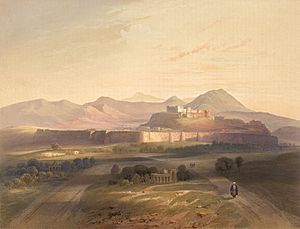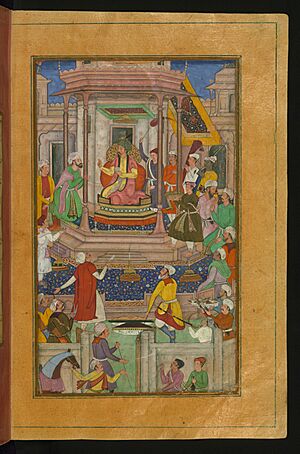Ghazni facts for kids
Quick facts for kids
Ghazni
غزنی
|
|
|---|---|

Citadel of Ghazni, seen from Tapa Sardar.
|
|
| Country | |
| Province | Ghazni Province |
| District | Ghazni District |
| Elevation | 2,219 m (7,280 ft) |
| Population | |
| • Total | 190,424 |
| Time zone | UTC+4:30 (AST) |
Ghazni is a city in southeastern Afghanistan. About 190,000 people live there. The city is very important because it sits on Highway 1. This road has been the main link between Kabul and Kandahar for thousands of years.
Ghazni is located on a high plateau, about 2,219 meters (7,280 feet) above sea level. It is about 150 kilometers (93 miles) south of Kabul. The city is also the capital of Ghazni Province. The name Ghazni comes from the Persian word "ganj," which means 'treasure.'
Many old and famous places are in Ghazni. These include the Ghazni Citadel, the Minarets of Ghazni, and the Palace of Sultan Mas'ud III. These sites have attracted visitors and archaeologists for centuries.
Long ago, before Islam, different groups lived here. They followed religions like Zoroastrianism, Buddhism, and Hinduism. Arab Muslims brought Islam to Ghazni in the 7th century. Later, in the 10th century, Sabuktigin made Ghazni the capital of the powerful Ghaznavid Empire.
Ghazni has faced many conflicts throughout its history. In 2018, the Taliban briefly took control of the city. They captured it again in August 2021. In 2013, Ghazni was named the Islamic Capital of Culture by ISESCO.
Contents
Ghazni's Long History

Ghazni started as a small market town a very long time ago. Some people think it might be the city Gazaca mentioned by an ancient writer named Ptolemy.
Around 500 BCE, the Achaemenid king Cyrus II conquered the city. It became part of the Persian Empire. Later, in 329 BCE, Alexander the Great took control of the city. He called it Alexandria in Opiana.
By the 7th century CE, Ghazni was a big center for Buddhism. A Chinese traveler named Xuanzang visited a city called Jaguda in 644 CE. This was likely Ghazni.
Early Islamic Rule
In 683 CE, Arab armies brought Islam to the area. Later, in the late 9th century, Yaqub Saffari conquered the city. The Saffarids made the local Lawik dynasty pay taxes to them.
In 962, a Turkic commander named Alp-Tegin took over Ghazni. But the Lawik family briefly got it back. Then, Alp-Tegin's son, Abu Ishaq Ibrahim, recaptured the city with help.
For almost 200 years (977–1163), Ghazni was the amazing capital of the Ghaznavid Empire. This empire included parts of modern-day Afghanistan, Pakistan, and Iran. The Ghaznavids spread Islam into India. They brought back many treasures from Hindu temples.
Even though the city was destroyed in 1151 by the Ghorid ruler Ala'uddin, it was rebuilt. It became a second capital for the Ghorids in 1173.
Mongol Invasion and Later Empires
Between 1215 and 1221, the Khwarezmid Empire ruled Ghazni. Then, the city was destroyed again by the Mongol armies led by Ögedei Khan, son of Genghis Khan.
In the early 11th century, Ghazni was a very important place for Persian literature. This was because Sultan Mahmud (who ruled from 998–1030) brought many scholars, thinkers, and poets to his court.
The famous traveler Ibn Battuta visited Ghazni in 1333. He wrote that most of the city was in ruins. He also said it had a very cold climate.
Later, in 1504, Babur conquered the region. Ghazni remained under Mughal control until 1738. Then, the Iranian ruler Nader Shah invaded. After Nader Shah died, Ghazni became part of the Durrani Empire, which led to modern Afghanistan.

During the First Anglo-Afghan War, British forces captured Ghazni on July 23, 1839. The city's defenses were partly destroyed.
Modern Challenges and Rebuilding
The Civil war and fighting in the 1990s put Ghazni's old treasures at risk. But Ghazni's important location helped it recover.
After the 2001 U.S. invasion, the United States armed forces built a base in Ghazni. They helped with rebuilding projects and protected people from Taliban fighters. They also trained local police and army forces.
In 2010, the U.S. opened a Lincoln Learning Center in Ghazni. These centers offer English classes, libraries, internet, and other learning services. They aim to help thousands of Afghan citizens each month.
On August 10, 2018, the Taliban attacked the city in the Battle of Ghazni. Many people were killed, and buildings were burned. On August 12, 2021, the Taliban captured Ghazni again as part of their 2021 Taliban offensive.
Ghazni's Geography and Climate
Land Use in Ghazni
Ghazni is a center for trade and travel in central Afghanistan. Most of the land, about 28%, is used for farming. About 33% of the developed land is empty plots, and 31% is for homes. Some areas also have large government or public buildings. The city has four police districts and covers about 3,330 hectares. There are 15,931 homes in Ghazni city.
Ghazni's Weather
Ghazni has a climate that is between a cold dry climate and a humid continental climate. This means it has cold, snowy winters and warm, dry summers. Not much rain falls, and most of it comes as snow in winter or rain in spring. Winters are very cold because the city is so high up. The average temperature in January is about -5.9°C (21.4°F).
| Climate data for Ghazni | |||||||||||||
|---|---|---|---|---|---|---|---|---|---|---|---|---|---|
| Month | Jan | Feb | Mar | Apr | May | Jun | Jul | Aug | Sep | Oct | Nov | Dec | Year |
| Record high °C (°F) | 16.0 (60.8) |
17.8 (64.0) |
24.8 (76.6) |
28.0 (82.4) |
33.0 (91.4) |
36.3 (97.3) |
36.7 (98.1) |
35.6 (96.1) |
32.5 (90.5) |
29.9 (85.8) |
21.2 (70.2) |
16.6 (61.9) |
36.7 (98.1) |
| Mean daily maximum °C (°F) | 0.6 (33.1) |
2.3 (36.1) |
10.0 (50.0) |
18.0 (64.4) |
23.7 (74.7) |
29.2 (84.6) |
30.8 (87.4) |
30.5 (86.9) |
26.5 (79.7) |
19.0 (66.2) |
12.6 (54.7) |
5.4 (41.7) |
17.4 (63.3) |
| Daily mean °C (°F) | −5.9 (21.4) |
−4.4 (24.1) |
3.8 (38.8) |
11.0 (51.8) |
16.3 (61.3) |
21.4 (70.5) |
23.3 (73.9) |
22.2 (72.0) |
16.9 (62.4) |
10.3 (50.5) |
4.0 (39.2) |
−1.8 (28.8) |
9.8 (49.6) |
| Mean daily minimum °C (°F) | −10.6 (12.9) |
−9.0 (15.8) |
−1.5 (29.3) |
4.2 (39.6) |
8.1 (46.6) |
12.4 (54.3) |
15.1 (59.2) |
14.1 (57.4) |
8.3 (46.9) |
2.2 (36.0) |
−2.5 (27.5) |
−6.6 (20.1) |
2.8 (37.1) |
| Record low °C (°F) | −33.5 (−28.3) |
−29.2 (−20.6) |
−17.5 (0.5) |
−5.8 (21.6) |
0.0 (32.0) |
5.0 (41.0) |
7.7 (45.9) |
2.0 (35.6) |
−3.5 (25.7) |
−6.0 (21.2) |
−13.8 (7.2) |
−33.2 (−27.8) |
−33.5 (−28.3) |
| Average precipitation mm (inches) | 40.2 (1.58) |
53.9 (2.12) |
70.9 (2.79) |
49.9 (1.96) |
19.7 (0.78) |
1.9 (0.07) |
14.1 (0.56) |
4.7 (0.19) |
0.5 (0.02) |
4.1 (0.16) |
11.3 (0.44) |
25.8 (1.02) |
297 (11.69) |
| Average rainy days | 1 | 2 | 7 | 9 | 6 | 1 | 3 | 2 | 0 | 1 | 2 | 1 | 35 |
| Average snowy days | 6 | 7 | 4 | 1 | 0 | 0 | 0 | 0 | 0 | 0 | 1 | 5 | 24 |
| Average relative humidity (%) | 68 | 72 | 64 | 55 | 43 | 36 | 43 | 39 | 35 | 42 | 52 | 60 | 51 |
| Mean monthly sunshine hours | 175.3 | 174.8 | 227.6 | 258.6 | 314.3 | 346.2 | 353.2 | 341.8 | 324.5 | 293.9 | 256.4 | 194.6 | 3,261.2 |
| Source: NOAA (1958–1983) | |||||||||||||
People of Ghazni
The number of people living in Ghazni city grew from about 143,000 in 2015 to 270,000 in 2018. This happened because many people moved there to escape violence in other areas.
Ghazni has a mix of different ethnic groups. About 25% of the people are Tajik, 25% are Hazara, and 50% are Pashtun.
City Life and Resources
Getting Around Ghazni
In April 2012, the governor of Ghazni started work on the Ghazni Airport. The city is also right next to Afghanistan's main highway. This highway connects Kabul and Kandahar. There are also roads leading to other nearby towns and villages.
Learning in Ghazni
Ghazni has several public schools. Jahan Maleeka School is a school just for girls. It has over 5,000 students and 150 teachers. Another girls' school, Naswan Shaher Kohna School, has over 3,000 students. In 2012, about 41.2% of adults in Ghazni could read and write.
Water Supply
Ghazni City does not get much rainfall. In 2007, a gate on a 50-year-old dam broke. This caused worries about the city's water supply. The dam helps provide water for farming in Ghazni City and the areas around it. Nearby rivers have sometimes flooded, causing damage. However, efforts are being made to prevent this.
Sports in Ghazni
Ghazni has professional sports teams.
| Club | League | Sport | Venue | Established |
|---|---|---|---|---|
| Band-e-Amir Dragons | Shpageeza Cricket League | Cricket | Ghazni Cricket Ground | 2013 |
| Oqaban Hindukush F.C. | Afghan Premier League | Football | Ghazni Ground | 2012 |
- Stadiums
- Ghazni Cricket Ground
- Ghazni Ground
Famous People from Ghazni
Leaders and Rulers
- Sabuktigin: He founded the Ghaznavid dynasty.
- Mahmud of Ghazni: Son of Sabuktigin, he was the first independent ruler of the Ghaznavid Empire.
- Muhammad of Ghazni: Son of Mahmud of Ghazni and a Sultan.
- Masʽud I of Ghazni: Twin brother of Muhammad of Ghazni and a Sultan.
- Ibrahim of Ghazna: A Sultan of the Ghaznavid empire.
- Bahram-Shah of Ghazna: A Sultan of the Ghaznavids empire.
- Nur Muhammad Taraki: A former president of Afghanistan.
Writers and Thinkers
- Abu Rayhan Al-Biruni: A famous Iranian scholar and expert in many fields. He worked and died in Ghazni.
- Abu'l-Fadl Bayhaqi: A Persian historian and writer at the Ghaznavid court. He also died in Ghazni.
- Hakim Sanai Ghaznavi: An 11th/12th-century Persian Sufi poet and mystic.
- Faiz Mohammad Katib Hazara: A 19th/20th-century historian and writer.
- Abdul Rahman Pazhwak: An Afghan poet and diplomat.
Other Notable People
- Abdul Ahad Mohmand: The first Afghan citizen and fourth Muslim to travel to outer space.
Places to Visit in Ghazni
- Citadel of Ghazni: An ancient fortress.
- Minarets of Ghazni: Two tall, decorated towers.
- Palace of Sultan Mas'ud III: Ruins of an old palace.
- Tomb of Sebuktigin: The burial place of the Ghaznavid founder.
- Mausoleum of Sultan Mahmud: The tomb of the famous Sultan.
- Mausoleum of Sanai: The tomb of the Sufi poet.
- Museum of Islamic Art: A museum with Islamic artworks.
- Tapa Sardar Excavations: An archaeological site.
- Tomb of Al Biruni: The burial place of the famous scholar.
Sister Cities
Ghazni has two sister cities:
 Hayward, California, US
Hayward, California, US Giżycko, Poland
Giżycko, Poland
Images for kids
See also
 In Spanish: Gazni para niños
In Spanish: Gazni para niños











